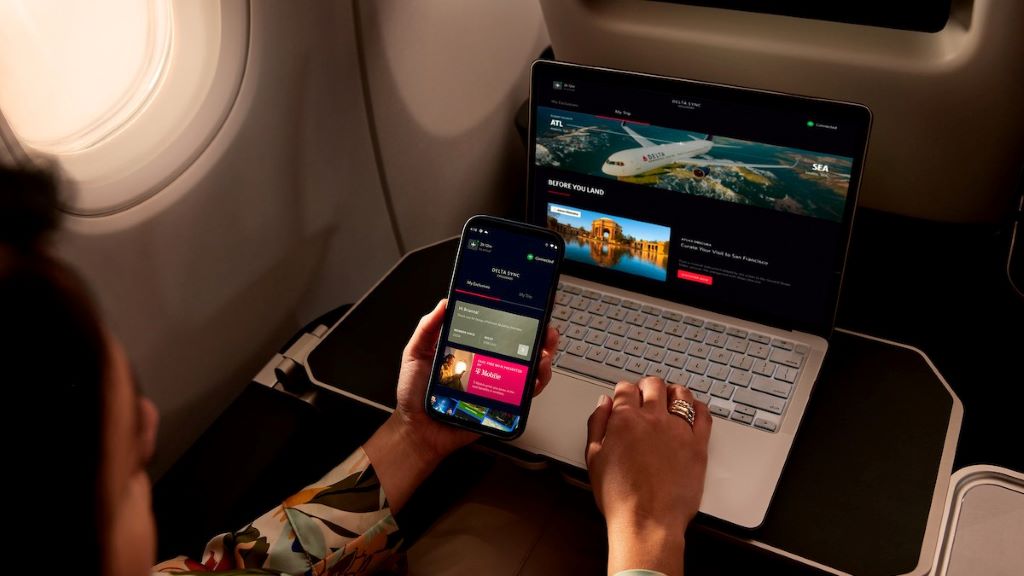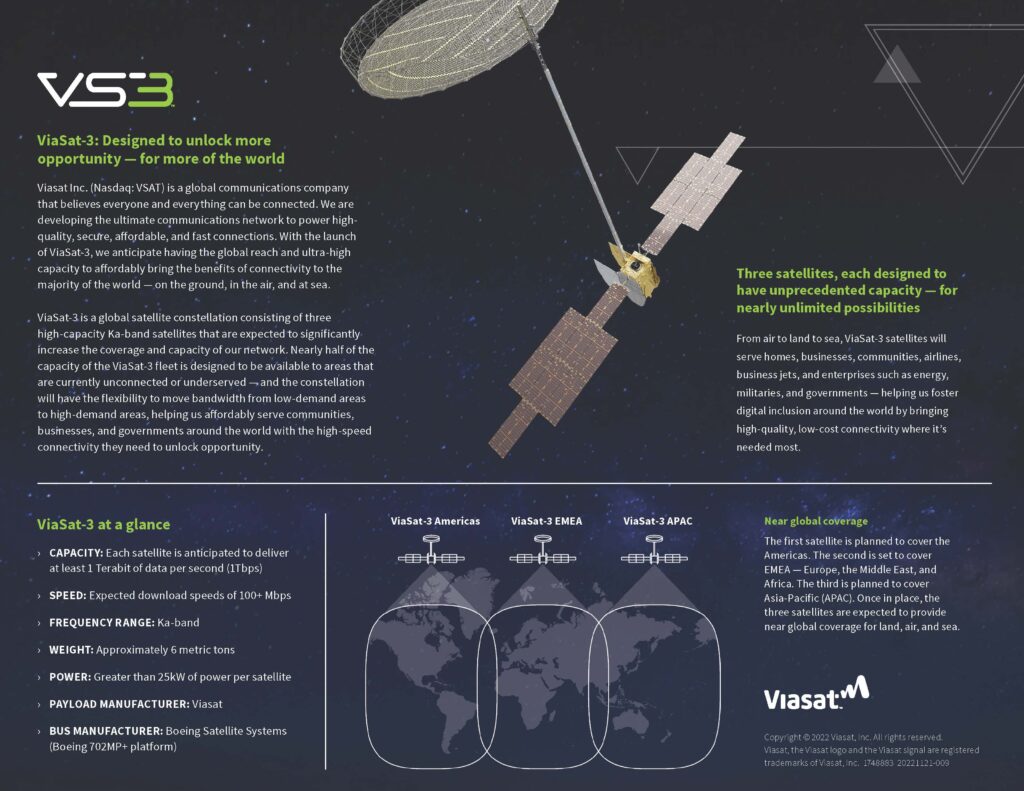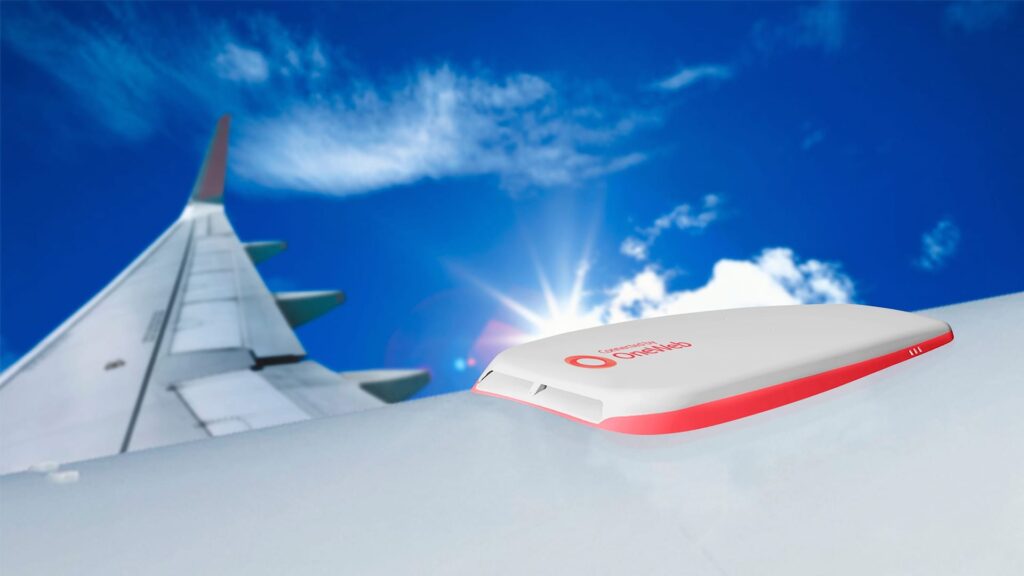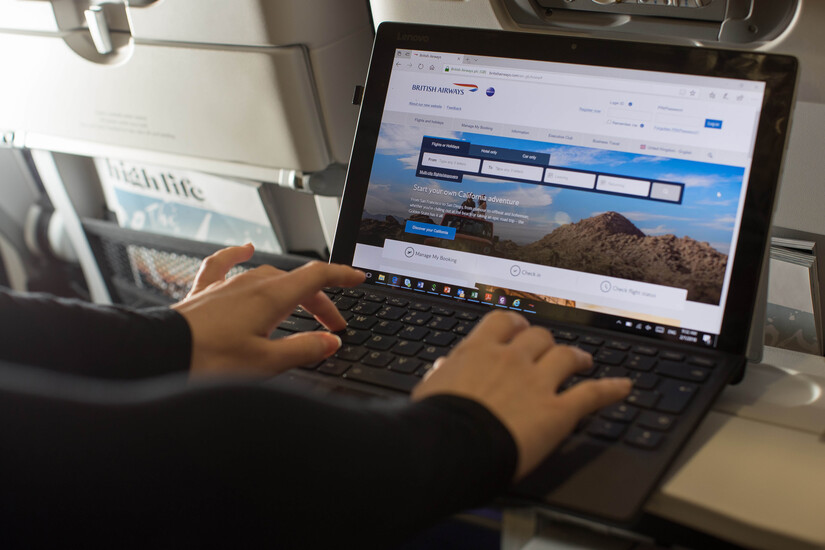The Future of Inflight Wi-Fi: Faster, Smarter, Seamless
Big changes are coming for your inflight Wi-Fi, with new satellites offering faster speeds, better coverage, and snappier response times
by John Walton
November 22, 2023

Photo: Courtesy of Delta Air Lines
It’s great news for you, the business traveler, as more and more planes are being equipped with upgraded systems that allow you to work online as smoothly as you would at home or in the office. This means that you can now easily do what you need to do while on board the airplane.
From new free service in business class to complimentary messaging options, revolutionary constellations consisting of hundreds of miniaturized low earth orbit satellites blanketing the world, massive new satellites the size of a city bus offering more Internet than we yet know what to do with, it’s all starting to feel very different than it did just five years ago.

Photo: Courtesy of Emirates
We need to get into the details to understand the hows and whys of how it all works and what changes are coming. After all, you’re sending those Slack messages and slide decks while hurtling through the sky eight miles high at nearly the speed of sound, so some tech will be involved.
The Internet comes to your plane one of two ways: from a ground cellular tower pointed upwards and from a satellite orbiting the Earth pointed downwards. Those satellites are traditional communications satellites in a geostationary earth orbit (GEO) or the newer kind of low earth orbit (LEO) satellites like OneWeb and Starlink.
GEO vs LEO
GEO satellites are massive in size and orbit just over 22,000 miles above the Earth at a fixed position. The fixed orbit also means that they cover a specific area, so — for example — Viasat’s high-speed North American satellite doesn’t cover international flights outside the region.

Photo: Courtesy of Viasat
The size of GEO satellites means they have a lot of transmission capacity (speed and bandwidth). However, their distance means they have high latency (the delay between your device sending a request to the Internet, bouncing off the satellite to the ground station back on Earth, the Internet dealing with that request, and the response traveling back to you). That means they can feel laggy, although providers have been working to speed up the rest of the process where they can.
The antennas and the streamlined radomes that cover them are also big, around the size of a person, which adds weight and drag to airplanes — something that airlines want to avoid.
Meanwhile, LEO satellites are much smaller and orbit about 1,200 miles. Their size means their transmission capacity is lower, but the shorter distance means their latency is lower, so the response feels snappier.
OneWeb Aviation test flight – long form from Eutelsat OneWeb on Vimeo.
The smaller size also means that more satellites can be launched at once: over OneWeb’s 20 launches, they’ve launched up to 40 satellites per rocket for nearly 600 satellites in orbit so far.
LEO is just starting to break into the aviation market, and the tiny size of the antennas needed for these close-in satellites is a reason why.
Ku-band
Ku-band, the original inflight Internet, was first utilized in the mid-2000s. Many international airlines still use these older connections provided by Panasonic to offer onboard Internet. OneWeb’s Low Earth Orbit (LEO) network also uses Ku-band to provide satellite-to-airplane links.

Photo: Courtesy of Eutelsat OneWeb
However, in recent years, Ku-band has been used less by GEO satellite providers for several technical reasons. Anuvu (formerly Global Eagle) stands out with its excellent service on European flights with Air France, while Intelsat (once Gogo’s airline business) also offers a reliable double-dish 2Ku service.
Ka-band
Ku-band was the technology that dominated the 2000s to 2010s, but Ka-band is now the leading technology for the 2010s to 2020s. The major players in this field are Viasat’s high-speed satellites in North America, which offer slower service through partners in Europe and Australia, and Viasat-formerly-Inmarsat’s Global Xpress, which provides global coverage and has been preferred by many airlines for their international planes.
Earlier this year, California-based satellite internet provider Viasat acquired its London-based rival Inmarsat, which is expected to bring significant improvements in the medium term over the next 5-10 years. Viasat is well-known for its fast inflight satellite internet service in North America. It was launched on JetBlue a decade ago and is now available on domestic and short-haul fleets of major US airlines such as American, Delta, and United.

Photo: Courtesy of Delta Air Lines
Viasat’s Ka-band has been the most reliable onboard wifi for the past decade. However, more satellites are required to extend this experience to international flights. Sadly, the two networks used by Viasat’s competitors—before its acquisition of Inmarsat—are incompatible, and there are no indications of them becoming so in the immediate future.
Hughes, which has its Jupiter network over North America, has recently entered the market directly. In addition, Hughes is offering a hybrid system that combines its own Ka-band GEO service with OneWeb’s Ku-band LEO. This highly technical combination should result in outstanding connectivity for North American flights.
Air-to-Ground
Back in the early days of onboard connectivity, the air-to-ground category referred to dedicated cellular tower dishes that pointed upwards to the sky instead of sideways to the ground. This is what many flyers would recognize as the original Gogo product, which is now owned by Intelsat.

Photo: Intelsat’s state-of-the-art satellite Wi-Fi equipment. Courtesy of Alaska Airlines
Although it is lightweight and easy to install, the capacity was only suitable for the demands of the 2000s. Even the upgrade from 3G to 4G in the early 2010s didn’t bring enough speed and bandwidth for the modern internet. As for 5G, there are still doubts about its suitability for in-flight connectivity.
The EAN: S-band and 5G hybrid
Currently, the only place where 5G air-to-ground Internet is used is in Europe. This service is provided by the Inmarsat (now Viasat) and Deutsche Telekom partnership, known as the European Aviation Network. The network uses a hybrid of S-band satellites and is only available in Europe.

Photo: Courtesy of British Airways
The EAN service is available on IAG airlines, which include British Airways, Iberia, Aer Lingus, and Vueling. However, the speeds on these airlines are not particularly impressive due to the contracted performance rather than technical limitations. The EAN service is also available on the Greek national carrier, Aegean, where the performance is excellent.




